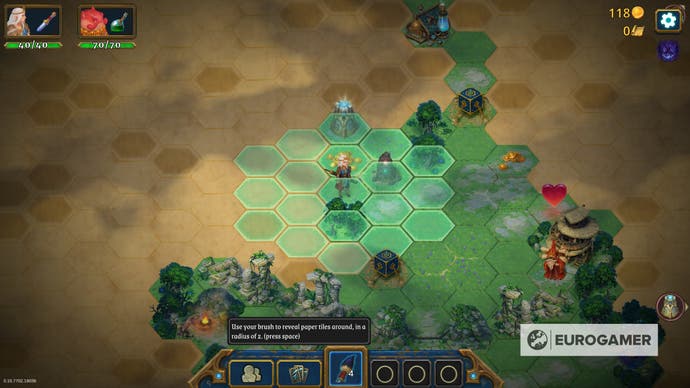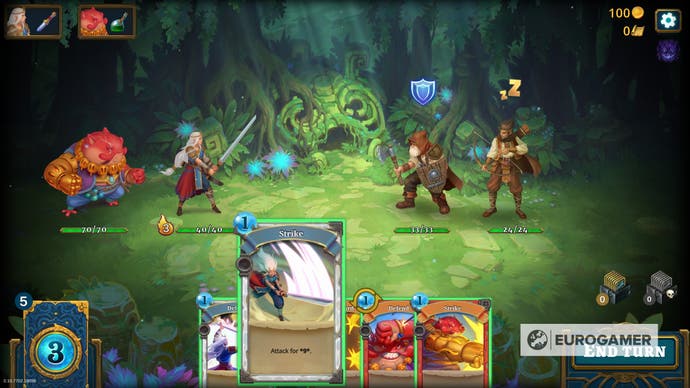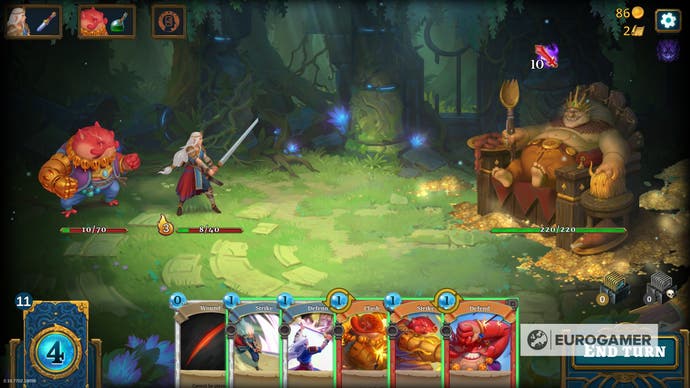Roguebook spins the Slay the Spire idea with confidence
Magic!
There's a confidence to Roguebook I really like, which I suppose I should expect from a new game by Magic: The Gathering creator Richard Garfield. It's not just in the presentation of the game, though that certainly helps - it's crisp and clear and colourful and characterful - but in the brand of strategy it offers underneath. This is a game made of familiar components and yet it feels satisfyingly new.
The overwhelming inspiration is Slay the Spire, that much is obvious. Not only is it a Roguelike deckbuilder, it goes as far as to copy the Strike and Defend cards in your opening deck. But I think we can probably consider Slay a template for the genre at this point anyway, so let's move on, because it's in the differences where Roguebook becomes interesting.
In Roguebook, you see, you don't control one hero but two. And each of these heroes has their own cards that make up your deck. In order for them to attack, you have to play their specific attack card, and the same goes for blocking. However, block is shared between characters, which means whichever character stands at the front, at turn's end, gets the benefit of the block. This is important, because it's the character standing at the front who takes damage. Positioning, therefore, is vital.
You don't want to strand your glass cannon at the front. Equally, you can't hide them in the back. Certain attacks move them forward automatically, you see, and others can only be used from the front. Therefore, you swap - you constantly swap. And everything ties into this. There's an upgrade you can apply, literally called combo, that makes a card cost one less energy (you begin with three each round) as long as the other character used an ability first. Do you see? Swip-swapping in combat is where the real skill lies.
The other skill comes in exploration, which I didn't expect but I'm quite taken with. Exploration is a kind of puzzle, and comes from the world being a partially-filled-in map. The only filled-in route is a short and direct one, from level-beginning to boss-battle end, the A to B. Everything else is hidden and it's up to you to reveal it, if you can. And you will want to, because out there are all kinds of things to improve your chances of winning with: money, opportunities to buy cards, gems to upgrade cards with, alchemists to transmute cards with, and so on.
You do all of this - you reveal the world - using a paint brush system. Simply, you click on the paint brush icon to reveal hexagonal tiles in a kind of circle around you. And when revealed, you can see whatever goodies those tiles may hold. However! You know what I'm going to say, don't you? You only have a few paint brushes. Each use depletes one, and once you're out, you have no choice but to give up exploring and head for the boss. You can earn more through combat, but if you've run out of crossed-sword combat tiles on your map, there's not much you can do.


The skill, therefore, comes - again - in positioning. In standing in the optimal place to reveal the most hidden tiles around you in one bang. And this isn't easy. Thankfully, there are things out there to help you. There are towers out there that reveal large areas around them, and eyes that reveal areas somewhere else. You can also loot ink pots from battles which modify the areas a paint brush can reveal: a straight-line from you instead of a circle around you, for instance, which can be enormously helpful. Plot your course carefully!
A few other things to note: there's a pet-like ally system, whereby you summon pets in battle which do things for you according to their spirit resource. Maybe they attack enemies at the end of each round, maybe they buff you, but if their spirit runs out, they disappear. There's also a tiered talent system for your heroes. You earn a point every so often and choose a character's ability to spend it on, or a joint ability for both of them.
I really like it. I really like the duality and the tag-team thinking, and the careful planning to maximise rewards from exploration. And I like the pace of it all. There's a satisfying briskness to combat, as the cartoon characters "snk!" their swords into the enemies, or fire cannons, or do all manner of things. And there was a really-quite-tough sheep-with-a-unicorn-horn enemy - what's not to like?
It's not all there yet, though. The game isn't due out until June. There are two more hero partners to implement, as well as a between-tries skill system, which sounds interesting. Best of all, though, there's a free demo being released this week as part of the Steam Games Festival (3rd-9th Feb) so you can try it too. Enjoy! And then come back and tell me what you think.



